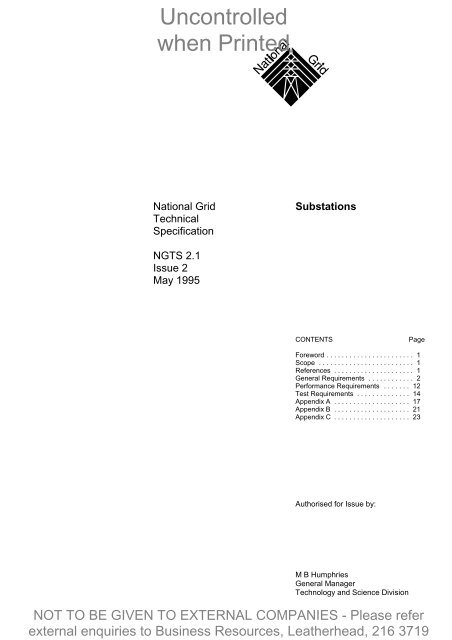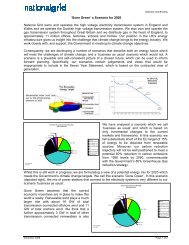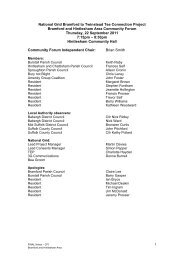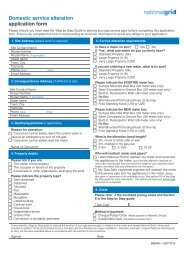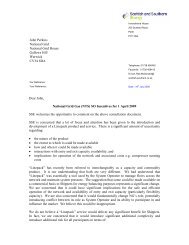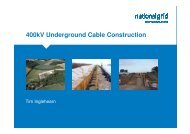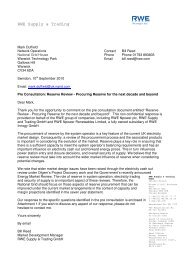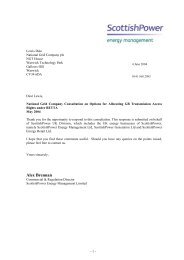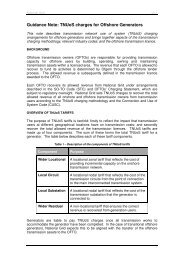Download PDF - National Grid
Download PDF - National Grid
Download PDF - National Grid
You also want an ePaper? Increase the reach of your titles
YUMPU automatically turns print PDFs into web optimized ePapers that Google loves.
<strong>National</strong> <strong>Grid</strong> Substations<br />
Technical<br />
Specification<br />
NGTS 2.1<br />
Issue 2<br />
May 1995<br />
CONTENTS Page<br />
Foreword....................... 1<br />
Scope ......................... 1<br />
References ..................... 1<br />
General Requirements ............ 2<br />
Performance Requirements ....... 12<br />
Test Requirements .............. 14<br />
Appendix A .................... 17<br />
Appendix B .................... 21<br />
Appendix C .................... 23<br />
Authorised for Issue by:<br />
M B Humphries<br />
General Manager<br />
Technology and Science Division
© The <strong>National</strong> <strong>Grid</strong> Company plc 1995<br />
No part of this publication may be reproduced,<br />
stored in a retrieval system, or transmitted in<br />
any form or by any means electronic, mechanical,<br />
photocopying, recording or otherwise, without<br />
the written permission of the NGC obtained from<br />
the issuing location.<br />
Registered Office<br />
<strong>National</strong> <strong>Grid</strong> House<br />
Kirby Corner Road<br />
Coventry<br />
CV4 8JY<br />
Registered in<br />
England and Wales<br />
No. 2366977<br />
Published by:<br />
The <strong>National</strong> <strong>Grid</strong> Company plc<br />
Burymead House<br />
Portsmouth Road<br />
Guildford, Surrey GU2 5BN
SUBSTATIONS<br />
FOREWORD<br />
NGTS 2.1<br />
Page 1 Issue 2<br />
May 1995<br />
This Document defines the technical requirements for substations connected to The <strong>National</strong> <strong>Grid</strong> Company<br />
plc (NGC) system and with equipment rated at 145, 300 or 420 kV. It is supported by the more specific<br />
NGTS documents at Level 3.<br />
This Specification is applicable to new construction and extensions to existing installations. It should<br />
however be noted that where a ‘Central Electricity Generating Board (CEGB) Standard' substation is to be<br />
extended the Contract may refer to obsolete Transmission Plant Specifications.<br />
1 SCOPE<br />
This functional Specification covers all types of substation with equipment installed for use on 132, 275 and<br />
400 kV 50 Hz systems. It is applicable to both open-terminal air-insulated (AIS) and metal-enclosed gasinsulated<br />
(GIS) substation constructions and covers equipment operated at lower voltages on the same<br />
substation site.<br />
All NGC plant and apparatus wholly within the substation and not covered more specifically by other NGTS's<br />
is within the scope of this document.<br />
2 REFERENCES<br />
The Health and Safety at Work Act 1974.<br />
The Factories Act 1961.<br />
The Electricity at Work Regulations 1989.<br />
IEC 694 (BS 6581) Common Clauses for High-Voltage Switchgear and Controlgear Standards.<br />
IEC 865 Calculation of the Effects of Short-Circuit Currents.<br />
EN 50-052 High-Voltage Switchgear and Controlgear for Industrial Use. Cast Aluminium Alloy Enclosures<br />
for Gas-Filled High-Voltage Switchgear and Controlgear.<br />
EN 50-064 Wrought Aluminium and Aluminium Alloy Enclosures for Gas-Filled High-Voltage Switchgear<br />
and Controlgear.<br />
BS EN 50-068 Wrought Steel Enclosures for Gas-Filled High-Voltage Switchgear and Controlgear.<br />
BS EN 50-069 Welded Composite Enclosures of Cast and Wrought Aluminium Alloys for Gas-Filled High-<br />
Voltage Switchgear and Controlgear.<br />
BS EN 50-089 Cast Resin Partitions for Metal Enclosed Gas-Filled High-Voltage Switchgear and<br />
Controlgear.<br />
BS EN 60-529 Classification of Degrees of Protection Provided by Enclosures.<br />
BS EN 61011 Safety Requirements for Mains Operated Electric Fence Energizers.<br />
BS 1710 Specification for Identification of Pipelines and Services.<br />
BS 5395: Part 3 Code of Practice for the Design of Industrial Type Stairs, Permanent Ladders and<br />
Walkways.
NGTS 2.1<br />
Page 2 Issue 2<br />
May 1995<br />
BS 7354 Code of Practice for Design of High-Voltage Open-Terminal Substations.<br />
NGTS 1 Overview, <strong>National</strong> <strong>Grid</strong> System.<br />
NGTS 2.2 Switchgear for the <strong>National</strong> <strong>Grid</strong> System.<br />
NGTS 2.13 Electronic Equipment.<br />
NGTS 2.19 Ancillary Light Current Equipment .<br />
NGTS 3.1.1 Substation Interlocking Schemes.<br />
NGTS 3.1.2 Substation Earthing.<br />
NGTS 3.1.3 Substation Auxiliary Supplies (Publication Mid 1995).<br />
NGTS 3.2.2 Disconnectors and Earthing Switches.<br />
3 GENERAL REQUIREMENTS<br />
3.1 Requirements for all Substations<br />
3.1.1 Statutory Requirements<br />
In addition to the requirement specified in Clause 4.1 of NGTS 1, the manner in which plant and equipment<br />
is installed as a system shall allow that system and its components to be operated and maintained within<br />
the requirements of principally The Health and Safety at Work etc Act 1974, The Factories Act 1961, The<br />
Electricity at Work Regulations 1989, The Provision and Use of Work Equipment Regulations 1992 and The<br />
Electricity Supply Regulations 1988 as amended 1990 and 1994. Particular attention shall be paid to safe<br />
access/egress from places of work and provision of a safe place of work.<br />
3.1.2 Design Life of Installation<br />
Unless otherwise specified by NGC, the substation installation including busbars, connections, insulators<br />
and structures shall be designed for a life of 40 years subject to periodic preventive maintenance being<br />
carried out in accordance with manufacturers or suppliers instructions.<br />
Where part of the installation would require replacement or mid-life refurbishment to achieve the specified<br />
design life then this shall be stated at the time of tendering. Tenderers shall declare the life cycle costs of<br />
equipment on request.<br />
3.1.3 Outage Constraints<br />
Unless otherwise specified or agreed by NGC the design of the substation shall permit installation,<br />
extension, operation and maintenance (preventive and corrective) with a maximum of one circuit and one<br />
busbar section out of service simultaneously. A busbar section is taken to be a part of either the main or<br />
reserve busbars. Associated busbar section and busbar coupler circuits may be considered to be part of<br />
the busbar section.<br />
NGC shall be advised at the Tender stage of any areas in which the requirements of this clause cannot be<br />
met.<br />
The line conductors of different outgoing circuits shall not be crossed unless otherwise agreed by NGC.<br />
3.1.4 Switchgear Local Control<br />
The installation of switchgear shall comply with the requirements of Clause 3.3 of NGTS 2.2.
3.1.5 Operational Access<br />
NGTS 2.1<br />
Page 3 Issue 2<br />
May 1995<br />
Reasonable access shall be provided to the isolation facilities of each disconnector and earthing switch,<br />
including the locking device, where fitted. Access shall comply with Clause 3.1.1 and shall be suitable for<br />
use by an unaccompanied person.<br />
Unless otherwise agreed with NGC the isolation facilities or locking devices shall be between 1 m and 1.8<br />
m above the floor level or platform provided for access and shall not be further than 750 mm horizontally<br />
from the edge of a platform.<br />
Access above ground level shall be from mobile or fixed platforms (though the latter may be accessed by<br />
ladder). Where movement of equipment within the substation would be restricted by the presence of ladders<br />
it is acceptable that these should be removable. Removable ladders and mobile platforms shall be easily<br />
handled and used on the finished substation surface by one person.<br />
Ladders and permanent platforms shall, where applicable, comply with BS 5395: Part 3. Other Standards<br />
may be acceptable by agreement with NGC.<br />
3.1.6 Requirements for Maintenance<br />
The substation layout shall make allowance for preventive or corrective maintenance within the outage<br />
constraints specified in Clause 3.1.3 and using procedures compliant with Clause 3.1.1.<br />
Access for maintenance shall be provided as follows:<br />
(i) The substation layout and surfaces shall be adequate to allow the access and use of powered access<br />
equipment, cranes and similar equipment required for any normal maintenance operation (circuit-breaker<br />
interrupter change, disconnector contact change, insulator cleaning etc). Suitable sealed surface roads<br />
shall be provided to substation main buildings and heavy items of plant (eg transformers), other surfaces<br />
should be finished in accordance with NGTS 2.10.<br />
(ii) Fixed platforms need not be provided for preventive or corrective maintenance requirements so long as<br />
access can be gained by the use of pre-formed scaffolding, portable ladders or, in outdoor substations,<br />
powered access equipment.<br />
Arrangements of any fixed platforms provided shall be to the approval of NGC and shall meet the<br />
requirements of BS 5395: Part 3. Other Standards may be acceptable by agreement with NGC.<br />
Maintenance shall be taken to include the replacement of any component or sub-component within the<br />
substation including GIS enclosures.<br />
Suppliers shall, on request, provide a written procedure for carrying out any proposed maintenance<br />
procedure in accordance with these requirements.<br />
3.1.7 Interlocking<br />
Substations shall be provided with a full interlocking scheme as specified in NGTS 3.1.1.<br />
Requirements of electronic interlocking schemes provided as part of substation control systems are<br />
specified in NGTS 3.7.11.<br />
3.1.8 Cranes & Lifting Equipment<br />
Fixed cranes should not be provided in indoor AIS substations except where specifically required for<br />
maintenance or repair purposes. Fixed cranes shall be provided in indoor GIS substations except where<br />
the supplier can demonstrate specifically that they are not required for dismantling or removing any part of<br />
the substation for maintenance or repair purposes.
NGTS 2.1<br />
Page 4 Issue 2<br />
May 1995<br />
Lifting beams or overhead cranes of adequate capacity shall be provided, where necessary, to assist in<br />
dismantling switchgear. Provision shall be made to inspect beams or cranes for insurance purposes and<br />
fit lifting tackle within the outage constraints specified in Clause 3.1.3.<br />
3.1.9 Facilities<br />
The following facilities shall be provided at all new 400 kV and 275 kV substations.<br />
(i) Adequate toilet and washing facilities for NGC operation and maintenance staff.<br />
(ii) A standby control room, this shall have provision to be equipped as a permit office and to be used for<br />
on-site drawing/record storage. At indoor GIS substations access to the control room shall not be through<br />
the switchgear hall and the room shall be designed to prevent ingress of SF 6/arc products in the event of<br />
a switchgear fault.<br />
(iii) At sites where SF 6 gas-filled equipment is installed, a standing area and suitable water and drainage<br />
connections for a mobile changing/shower facility. Such facilities are required to comply with NGC safety<br />
codes of practice for work on SF 6 -filled equipment that has been exposed to power arcing.<br />
(iv) A small mess room with sink.<br />
(v) An equipment store/small workshop.<br />
(vi) Vehicle parking.<br />
The size of the mobile changing/shower facility and workshop will be specified by NGC.<br />
The extent to which this Clause shall apply to 132 kV and lower voltage substations and extensions to<br />
existing installations shall be specified by NGC.<br />
3.1.10 Plant and Equipment Identification<br />
Labels shall be provided to allow identification of all plant and equipment and associated operating facilities<br />
and points of isolation. The following are normally required:<br />
(i) Each circuit-breaker, disconnector and earthing switch mechanism box shall carry a label giving the NGC<br />
operational reference (to be specified by NGC) of the device.<br />
(ii) For GIS equipment each partition between gas zones shall carry labels giving the identifier of the gas<br />
zone at each side of the partition.<br />
(iii) Each pressure gauge or pressure readout device shall carry a label identifying the parameter it is<br />
monitoring.<br />
(iv) Each valve (including self-sealing gas filling valves) shall carry a label identifying its function.<br />
(v) Each control handle or switch for plant operation shall carry a label identifying its function.<br />
(vi) Each point of LV isolation associated with plant shall carry a label identifying its function.<br />
(vii) Each cabinet, cubicle or kiosk shall carry a label identifying the equipment contained within it.<br />
The detailed wording of labels shall be to the approval of NGC. The labels shall be sufficiently durable for<br />
the application and environment in which they are to be used. Stencilling of items which may require<br />
repainting during the life of the substation shall not be acceptable.<br />
3.1.11 Current Transformers<br />
Unless otherwise agreed with NGC, the accommodation of current transformers shall be as specified in<br />
Appendix A and their location shall be as specified in Appendix B.
3.1.12 Voltage Transformer Secondary Isolation<br />
NGTS 2.1<br />
Page 5 Issue 2<br />
May 1995<br />
Voltage transformer secondary isolation links, or other means of positive isolation to the approval of NGC,<br />
shall be provided in a separate isolation box mounted between 1 m and 1.8 m above substation floor or<br />
access platform level. The door of the isolation box shall be padlockable by means of NGC's standard<br />
padlock type.<br />
3.1.13 Compressed Air Storage Systems<br />
Where required, a central compressed air storage system shall be provided, the technical requirements will<br />
be specified in the Contract.<br />
3.1.14 Substation Auxiliary Cable Routing<br />
Cable trenches shall be used between main substation buildings and dispersed relay rooms or, in the case<br />
of a central relay room, between the relay room and the common marshalling point for each primary circuit.<br />
Cables between dispersed relay rooms or circuit marshalling points and local plant may be buried direct<br />
where armoured cables are used; in all other circumstances cable ducts may be used. In relay rooms and<br />
control rooms cables shall be run in overhead racks and computer floors shall not be provided. The location<br />
of all buried cables and ducts shall be adequately recorded.<br />
3.1.15 Light Current Equipment<br />
Electronic equipment shall be located in accommodation commensurate with its environmental performance<br />
which is classified in NGTS 2.13 and NGTS 2.6 as appropriate. Where reasonably practicable, co-location<br />
of protection, control and measurement systems in a common room is preferred.<br />
Heaters and/or dehumidifiers shall be provided in light current accommodation in order to meet<br />
the requirements of NGTS 2.13 Class C (minimum ambient temperature -10bC, relative humidity 10-100%)<br />
under all ambient conditions. Where fixed heating is provided it shall be thermostatically controlled.<br />
Where no fixed heating is provided, provision shall be made for raising the air temperature in the vicinity of<br />
all equipment associated with any one circuit to 15bC without causing condensation on the equipment.<br />
All panels housing secondary equipment sited in equipment rooms shall have provision to be padlocked.<br />
3.1.16 Substation Earthing<br />
Substation earthing systems shall be designed and installed in accordance with NGTS 3.1.2.<br />
3.1.17 Substation Auxiliary Supplies<br />
Substation auxiliary supplies shall be designed and installed in accordance with NGTS 3.1.3.<br />
3.1.18 Environmental<br />
The guidelines for substation siting and design given in Appendix C shall be followed, with particular<br />
attention paid to Clause C2.2 and Sections C3 and C4.<br />
3.1.19 NGC will specify requirements for site security provisions and equipment on a site by site basis.<br />
The use of electric pulse security fences to BS EN 61011 is the preferred option for sites requiring high<br />
security. Perimeter fences meeting statutory 2.4 m height requirements, incorporating electric pulse security<br />
systems on lower security sites, will be considered if it can be demonstrated that there is a cost benefit over<br />
the use of NGC standard fencing over the life of the substation.<br />
3.2 Requirements for AIS Substations<br />
The layout of AIS shall be arranged to ensure the integrity of the air space between live parts and other<br />
conductors (whether earthed or at different potential) for the rated voltage conditions for which the
NGTS 2.1<br />
Page 6 Issue 2<br />
May 1995<br />
substation is designed. Safety to persons shall be maintained by the provision of adequate clearance to<br />
live parts for maintenance, vehicular and pedestrian access. Where adequate safety clearances cannot be<br />
maintained, barriers or fences shall be provided to limit access, these barriers or fences shall be to the<br />
approval of NGC. The need to extend substations with the minimum of disruption to normal operation shall<br />
be considered in the design and layout of the equipment. The extent of possible future extension will be<br />
defined in the Contract.<br />
3.2.1 Electrical Clearances<br />
Where equipment configurations have not been subject to type or routine tests in accordance with IEC 694<br />
the electrical clearances listed in Table 1 shall be applied.<br />
Table 1 Substation Electrical Clearances<br />
Nominal System<br />
Voltage<br />
BIL/SIL Basic Electrical<br />
Clearance<br />
(phase to earth)<br />
kV (rms) kV (p) m<br />
(Notes 2,3)<br />
11 (Note 1) 0.5 0.25<br />
22 (Note 1) 0.5 0.33<br />
33 170 0.5 0.43<br />
66 325 0.7 0.78<br />
132 550/650 1.1 1.4<br />
275 1050/850 2.1 2.4<br />
400 1425/1050 2.8 3.6<br />
Note 1 To be specified by NGC in the Contract.<br />
Phase-to-Phase<br />
Clearance<br />
Note 2 Minimum clearance of 500 mm specified to cover vermin and bird interference.<br />
Note 3 Under some circumstances temporary infringement of phase to earth clearances during earth switch<br />
operation may be permitted. Refer to NGTS 3.2.2.<br />
It should be noted that Table 1 lists MINIMUM clearances and an appropriate additional allowance shall be<br />
made by the Supplier for constructional tolerances, effects of short-circuit, wind effects etc.<br />
3.2.2 Safety Clearances/Distances<br />
The safety clearances to be maintained in all AIS installations are listed in Table 2.<br />
Table 2 Substation Safety Clearances/Distances<br />
Nominal System<br />
Voltage<br />
kV m<br />
(Note 1)<br />
Safety Distance<br />
(From NGC Safety<br />
Rules)<br />
Design<br />
Clearance for<br />
Safety<br />
(vertical)<br />
m<br />
(Note 2)<br />
m<br />
Design<br />
Clearance for<br />
Safety<br />
(horizontal)<br />
m<br />
(Note 3)<br />
11/22/33 0.8 3.2 2.3 2.4<br />
Insulation<br />
Height<br />
(pedestrian<br />
access)<br />
m<br />
(Note 4)
Nominal System<br />
Voltage<br />
Safety Distance<br />
(From NGC Safety<br />
Rules)<br />
Design<br />
Clearance for<br />
Safety<br />
(vertical)<br />
Design<br />
Clearance for<br />
Safety<br />
(horizontal)<br />
66 1.0 3.4 2.5 2.4<br />
132 1.4 3.8 2.9 2.4<br />
275 2.4 4.8 3.9 2.4<br />
400 3.1 5.5 4.6 2.4<br />
NGTS 2.1<br />
Page 7 Issue 2<br />
May 1995<br />
Insulation<br />
Height<br />
(pedestrian<br />
access)<br />
It should be noted that Table 2 lists MINIMUM clearances and an appropriate additional allowance shall be<br />
made by the Supplier for constructional tolerances.<br />
Note 1 Persons shall not allow any part of their body or any object to infringe this distance to exposed<br />
conductors operated at high voltage.<br />
Note 2 The minimum clearance from a live conductor to a point to which pedestrian access is permitted.<br />
These figures are derived by adding the 'personal reach' (the vertical reach of a person with upstretched<br />
hand), which is taken to be 2.4 m, to the appropriate Safety Clearance.<br />
These figures should be taken as the 'section clearance' when this dimension is considered in the substation<br />
design.<br />
Note 3 These figures may be used by agreement with NGC. In general the vertical design clearance should<br />
be applied in all directions.<br />
Note 4 The minimum clearance from the lowest insulation part of a support insulator to a point to which<br />
pedestrian access is permitted.<br />
3.2.3 Clearance to Roadways<br />
The clearances to roadways to which vehicular access is required shall, unless otherwise agreed by NGC,<br />
allow unrestricted movement of a 2.4 m high vehicle. To comply with NGC safety codes of practice and<br />
obviate the need to use temporary earthing the clearances from live conductors to a 2.4 m high vehicle<br />
spanning the full width of the roadway shall be as listed in Table 2, Design Clearance for Safety (vertical).<br />
Height barriers shall be provided at entrances to the substation and/or within the substation to restrict<br />
access for vehicles exceeding the maximum height for which unrestricted access is allowable. These<br />
barriers shall be designed to be opened and shall have a facility to apply a padlock to secure them in the<br />
closed position.<br />
3.2.4 Substation Profile<br />
To limit the environmental impact of the substation the height of the highest component of outdoor<br />
substations should be kept to a practical minimum to achieve a low substation profile. Unless otherwise<br />
agreed by NGC, on new sites maximum heights of equipment shall not exceed the values listed in Table<br />
3. At existing sites the height of existing equipment shall not be exceeded.
NGTS 2.1<br />
Page 8 Issue 2<br />
May 1995<br />
Table 3 Maximum Equipment Heights in Substations<br />
Nominal System Voltage Maximum Equipment Height<br />
kV m<br />
132 7.5<br />
275 10<br />
400 12.5<br />
3.2.5 Substation Area<br />
Unless otherwise specified, the substation shall be designed to minimise the land area required.<br />
3.2.6 Earthing Devices<br />
The required locations of earthing devices will be specified by NGC.<br />
Earthing switches in accordance with NGTS 2.2 shall be provided at circuit entries ('line' earth switches) and<br />
at one position on each section of busbar.<br />
At remaining locations, other types of interlocked earthing device which meet the specified rating may be<br />
used (for example, Fixed Earthing Devices in accordance with NGC Transmission Plant Specification<br />
(Application) TPS 3/4).<br />
3.2.7 Portable Earthing<br />
Provision shall be made to employ NGC's standard portable earthing equipment. This equipment is<br />
designed for use with tubular conductors with diameters in the range 10-90 mm, or with diameters of 127<br />
mm, 140 mm or 190/200 mm. Further details are available, on request, from NGC. Where flexible<br />
conductors are used as substation conductors or where tube sizes are incompatible with the earthing<br />
equipment then earthing stubs shall be provided. The number and location of earthing stubs shall be to the<br />
approval of NGC.<br />
Points for attachment of the earth end of portable earthing leads shall be provided at each switchgear<br />
structure. This may be by 'D' loops or by other means approved by NGC. Each attachment point shall be<br />
connected to the substation earthing mat by a fully rated conductor/conductors. Allowance shall be made<br />
for the attachment of sufficient leads at each point to match the switchgear rating.<br />
3.2.8 Relay Rooms<br />
Central or dispersed relay rooms may be provided to meet the protection performance requirements stated<br />
in NGTS 2.6. If a central relay room is to be supplied at 400 kV double busbar substations, the supplier<br />
shall demonstrate to NGC that the protection performance requirements can be achieved. Dispersed relay<br />
rooms shall be transportable with facilities for ease of site connection, eg heavy duty plug and socket<br />
connectors and the protection and control equipment shall be pre-wired, factory assembled and factory<br />
tested.
3.3 Requirements for GIS Substations<br />
NGTS 2.1<br />
Page 9 Issue 2<br />
May 1995<br />
The following requirements apply to phase-segregated GIS designs with a rated voltage of 300 or 420 kV.<br />
They shall also apply, where appropriate, to lower voltage designs, however in this case the extent of<br />
compliance required shall be subject to agreement with NGC.<br />
3.3.1 Buildings<br />
GIS installations comprising two or more circuit breakers shall be housed in a building so as to minimise<br />
erection and life cycle maintenance costs. The building shall be of minimum cost construction consistent<br />
with environmental and planning requirements.<br />
3.3.2 AIS Connections<br />
Where AIS connections are associated with a GIS substation then the requirements listed under 3.2 shall<br />
apply to those connections.<br />
3.3.3 Segregation of Gas Zones<br />
The equipment shall be segregated into sufficient independent gas zones to allow the requirements of<br />
Clause 3.1.6 to be met. Unless otherwise agreed with NGC, circuit-breakers shall be accommodated in<br />
separate gas zones from other equipment.<br />
3.3.4 Gas Zone Barriers<br />
Gas zone barriers (partitions) shall be designed to withstand the differential pressures to which they may<br />
be subjected during preventive or corrective maintenance. A reduction of the dielectric properties of<br />
adjacent gas zones containing live high-voltage conductors by lowering gas pressures will not be<br />
acceptable.<br />
3.3.5 Portable Maintenance Earthing Devices<br />
Provision shall be made for fitting Portable Maintenance Earthing Devices (PMED's) where these are<br />
required to permit maintenance/testing. The principal applications of PMED's are to allow an earthing switch<br />
that would normally be the point of earthing, to be itself maintained and to earth cable sealing ends with the<br />
isolation link removed.<br />
The PMED's shall be rated in accordance with the requirements of NGTS 2.2.<br />
Proposals for the location of PMED positions shall be submitted to NGC for approval before the substation<br />
design is finalised.<br />
Positions at which PMED's may be fitted shall be identified by painting the access covers green. The<br />
PMED's shall be identified by painting in a red/white striped pattern externally so that they can be clearly<br />
seen when in position. Other alternative means of identification may be employed to the approval of NGC.<br />
Two three-phase sets of PMED's shall be supplied for each substation or, if the PMED's are of more than<br />
one type, two three-phase sets of each type shall be supplied.<br />
3.3.6 Disconnector Lock-Out<br />
If the GIS disconnectors supplied cannot be demonstrated to perform their rated duties when filled with SF 6<br />
gas at atmospheric pressure then arrangements shall be made to prevent operation when gas density is<br />
lower than the 'low' alarm setting.<br />
3.3.7 SF 6 Gas Service Connections<br />
The gas service connection for each gas zone shall be readily accessible without the use of special access<br />
equipment. Proposed access arrangements shall be to the approval of NGC.<br />
A schematic diagram shall be provided showing the gas zones within a bay and their relationship to the
NGTS 2.1<br />
Page 10 Issue 2<br />
May 1995<br />
primary plant of that circuit or busbar section. Where gas service connections are grouped together the<br />
diagram shall be displayed adjacent to this point, otherwise it shall be displayed at the Local Control Cabinet<br />
(LCC).<br />
Filling points shall be fitted with self-sealing valves of a design to the approval of NGC. Gas service valves,<br />
lockable by means of NGC's standard padlock type, shall also be provided at each filling point.<br />
Alternatively, where self-sealing valves are fitted directly to the enclosures, a lockable cover to prevent<br />
unauthorised access to the valve shall be provided. This cover shall be lockable by means of NGC's<br />
standard padlock.<br />
Provision shall be made for the use of an in-line dust filter at each filling point, either by permanently<br />
installing a filter at each point or providing a separate filter that can be fitted between the gas service hose<br />
and the self-sealing valve.<br />
3.3.8 Pressure/Density Indication<br />
Facilities for indicating the gas pressure or density in each gas zone shall be provided. Systems offering<br />
facilities for remote indication are preferred. Where the indication is of density this shall be displayed as an<br />
equivalent pressure at a reference temperature. The equipment shall be permanently installed and all<br />
displays shall be readable from the substation floor level or from access walkways.<br />
3.3.9 SF 6 Gas Alarm Scheme<br />
Each gas zone shall be fitted with a density monitor with two falling alarm settings. These shall be set to<br />
the switchgear manufacturers recommended 'falling' and 'low' alarm densities and shall be connected to the<br />
substation alarm scheme. The grouping of 'low' alarms at the normal substation control point shall be such<br />
that the section of equipment which requires isolation from the system can be readily identified.<br />
Where leakage of gas from a high pressure gas zone to an adjacent lower pressure gas zone may result<br />
in the rupture of the pressure relief device of the lower pressure zone before a falling pressure alarm is<br />
received from the high pressure zone then the lower pressure zone shall be fitted with a high density alarm.<br />
For indoor substations, an audible alarm scheme shall be provided in the substation building to warn<br />
operators of a major loss of SF 6 gas. This shall be connected to operate at the low pressure alarm setting<br />
of each gas zone. Controls shall be provided at the substation control point to reset and isolate the audible<br />
alarm. Visual indications shall be provided in the switchhouse, to show that the audible alarm is in service<br />
and outside the main entrances to the switchhouse, to indicate that the alarm has operated. Provision shall<br />
be made to isolate the alarm contact of each gas zone independently so that individual alarms can be<br />
disabled during maintenance, such isolation shall not prevent the receipt of a 'low' pressure alarm at the<br />
control points.<br />
Each density monitor shall be provided with a means of checking initiation of the 'falling' and 'low' density<br />
alarms without reducing the pressure in the main compartment. The method of providing this facility shall<br />
be to the approval of NGC.<br />
3.3.10 Bursting Discs & Explosion Vents<br />
Bursting discs and explosion vents shall be installed so as to eject debris away from normally accessible<br />
areas. They shall be set to minimise danger to personnel.<br />
3.3.11 Identification of Pipework<br />
Fixed gas and hydraulic pipework shall be identified in accordance with BS 1710.<br />
3.3.12 Identification of Gas Zone Barriers<br />
The position of each non-breathing gas zone partition shall be clearly identified by painting the flange of the<br />
GIS enclosure where the partition is fitted in a distinctive colour.
NGTS 2.1<br />
Page 11 Issue 2<br />
May 1995<br />
Labels shall be fixed to the enclosure at each non-breathing gas zone partition showing the identifier of the<br />
gas zones at each side of that partition.<br />
3.3.13 Cable Testing<br />
Where high voltage cables are terminated directly in GIS enclosures then provision must be made for D.C.<br />
cable testing.<br />
The point of disconnection for cable testing and the connections between it and the cable shall be<br />
demonstrated to meet the requirements of NGTS 2.2 for D.C. withstand voltage.<br />
In all cases a fixed or temporary earthing device shall be provided for applying an earth between the point<br />
of isolation and the cable sealing end. It shall be possible to apply this earthing device using an insulated<br />
tool to the approval of NGC and leave it in place while making or breaking the point of isolation.<br />
Where specified, provision shall be made for installing a D.C. test bushing to allow cables to be tested from<br />
the substation end. Where a test bushing is not supplied as part of the Contract then the installation shall<br />
be designed to permit the use of one of NGC's existing bushings. Details of available bushings will be<br />
supplied on request.<br />
Suppliers shall provide details of proposed cable testing arrangements with Tenders.<br />
3.3.14 Primary Injection Testing of CT's<br />
Provision shall be made for carrying out primary injection tests on all current transformers without requiring<br />
internal access to any chamber.<br />
3.3.15 Partial Discharge Measurement<br />
Capacitive couplers for diagnostic monitoring of the GIS equipment and transient voltage measurements<br />
are required to be located in all phases at the sealing ends of each cable connected circuit, at the SF 6 side<br />
of each transformer bushing and adjacent to the SF 6 /air bushings of each circuit connected to AIS<br />
equipment. In addition couplers shall be located in all phases at approximately 20 m intervals between<br />
these points such that all parts of the GIS equipment are between two couplers and no more than 20 m from<br />
either of these couplers. Proposals shall be to the approval of NGC.<br />
To facilitate the use of couplers for in-service monitoring, coupler signal connections shall be cabled to<br />
ground level and suitable test boxes provided at locations agreed with NGC. Signal connections in the test<br />
box shall be N series 50 ohm sockets. To limit interference, cables between the couplers and test boxes<br />
shall be double screened co-axial.<br />
3.3.16 Desiccant<br />
All gas zones shall have desiccant material provided in each phase to assist in the absorption of water<br />
vapour and gaseous acidic products.<br />
3.3.17 Location of Light Current Equipment<br />
Equipment panels may be located in the switchgear building either adjacent to the switchgear, generally<br />
conforming to bay widths, or in an annexe. Such equipment, together with its accommodation, shall meet<br />
the requirements of Class IP 54 of BS EN 60 529.<br />
3.4 Requirements for Earthing Systems and Earthing of Plant<br />
The requirements for earthing systems and earthing of plant are defined in NGTS 3.1.2.
NGTS 2.1<br />
Page 12 Issue 2<br />
May 1995<br />
4 PERFORMANCE REQUIREMENTS<br />
4.1 Requirements for all Switchgear<br />
4.1.1 Jointing of Current Carrying Conductors<br />
The method of jointing site-assembled current carrying conductors (except those internal to GIS equipment)<br />
shall be such as to avoid electrochemical reactions or the effects of corrosion. Such joints shall be expected<br />
to have a service life of at least 40 years. Jointing methods shall be to the approval of NGC.<br />
4.2 Requirements for AIS<br />
4.2.1 Mechanical Design<br />
Equipment shall be designed to withstand the maximum force to which it may be subjected in its lifetime.<br />
In order to establish the total mechanical forces acting on equipment and supporting structures it is<br />
necessary that consideration be given to forces resulting from:<br />
(a) Short-circuit current<br />
(b) Wind loading<br />
(c) Deadweight<br />
(d) Ice covering<br />
(e) Conductor tension<br />
These forces shall be calculated in accordance with Section 3.2 of BS 7354:1990 and factors of safety<br />
applied in accordance with Section 3.3.<br />
Other internationally recognised Specifications or Standards may be acceptable as an alternative to<br />
BS 7354 subject to the agreement of NGC.<br />
Where the design of equipment imposes additional forces to those listed above, then the Supplier shall take<br />
account of these forces in his design.<br />
4.2.2 Busbars, Connections & Connectors<br />
These shall be rated for normal current, short time withstand current and maximum radio interference<br />
voltage in accordance with NGTS 2.2 and IEC 694.<br />
Table 6 of IEC 865: Recommended Highest Temperatures for Mechanically Stressed<br />
Conductors during a Short Circuit<br />
Type of conductor Maximum recommended conductor<br />
temperature during a short circuit<br />
Bare conductors, solid or stranded:<br />
Cu, Al or Al alloy<br />
Bare conductors, solid or stranded:<br />
steel<br />
200bC<br />
300bC
NGTS 2.1<br />
Page 13 Issue 2<br />
May 1995<br />
Table 4 Recommended Highest Temperatures for Non-Mechanically Stressed Conductors<br />
During a Short Circuit<br />
Type of conductor Maximum recommended conductor<br />
temperature during a short circuit<br />
Bare conductors, solid or stranded:<br />
Cu<br />
Bare conductors, solid or stranded:<br />
Al or Al alloy<br />
Bare conductors, solid or stranded:<br />
steel<br />
405bC<br />
325bC<br />
300bC<br />
The maximum conductor temperature after passage of rated short time current shall not exceed the<br />
recommended values given in table 6 of IEC 865 for mechanically stressed conductors and Table 4 above<br />
for non mechanically stressed conductors. The initial conductor temperature shall be taken to be the rated<br />
maximum ambient temperature for the equipment. Table 6 of IEC 865 is reproduced on the preceding page<br />
for clarity.<br />
4.3 Requirements for GIS<br />
4.3.1 Pressurised Gas-Filled Enclosures<br />
These shall be designed and manufactured in accordance with the following CENELEC Standards:<br />
EN 50-052<br />
EN 50-064<br />
BS EN 50-068<br />
BS EN 50-069<br />
4.3.2 Cast Resin Partitions<br />
Cast resin partitions (barriers) shall be designed and manufactured in accordance with CENELEC Standard<br />
EN 50-089.<br />
4.3.3 Internal Arcing<br />
In principle, the gas zones, when at design pressure, shall show no external effect resulting from an internal<br />
arc of rated short-time current for a duration not less than the maximum main protection fault clearance time.<br />
On small gas zones, operation of the safety device may occur within main protection fault clearance time.<br />
When gas zones are subjected to an internal arc of rated short-time current for a duration not less than the<br />
back-up or breaker-fail protection fault clearance time, the resulting effect shall be restricted to operation<br />
of the safety pressure relief device(s) or the appearance of a hole, provided there is no ejection of<br />
fragmented parts.<br />
The fault clearance times to be used in assessing this performance are as follows:<br />
Rated Voltage<br />
(kV)<br />
Main Protection<br />
(ms)<br />
420 140 300<br />
300 160 500<br />
145 180 1000<br />
Back-Up or Breaker Fail<br />
Protection (ms)<br />
Compliance with this requirement shall be demonstrated by means of calculations or tests. On equipment<br />
having three phases in a common enclosure, or gas zone, allowance shall be made for the possibility of
NGTS 2.1<br />
Page 14 Issue 2<br />
May 1995<br />
faults evolving to include two or more phases.<br />
4.3.4 Couplers for Partial Discharge Measurement<br />
Partial discharge couplers (the requirement for which is specified in Clause 3.3.15) shall be sensitive to all<br />
frequencies in the range 0.1 - 1.5 GHz and shall give an output signal suitable for a spectrum analyser.<br />
Couplers shall have a linear response in the frequency range 50 Hz - 300 MHZ and a capability to make<br />
D.C. 'trapped charge' measurements.<br />
5 TEST REQUIREMENTS<br />
5.1 Type Tests<br />
5.1.1 Busbars, Connections & Connectors<br />
Electrical type tests shall be performed in accordance with IEC 694.<br />
Tests of mechanical performance shall be subject to agreement between the Supplier and NGC dependant<br />
on the application.<br />
5.1.2 Pressurised Gas-Filled Enclosures<br />
These shall be tested, where applicable, in accordance with the following CENELEC Standards:<br />
EN 50-052<br />
EN 50-064<br />
BS EN 50-068<br />
BS EN 50-069<br />
5.1.3 Cast Resin Partitions<br />
Cast resin partitions (barriers) shall be tested in accordance with CENELEC Standard EN 50-089.<br />
5.2 Routine Tests at Manufacturers Works<br />
5.2.1 Pressurised Gas-Filled Enclosures<br />
These shall be tested in accordance with the following CENELEC Standards:<br />
EN 50-052<br />
EN 50-064<br />
BS EN 50-068<br />
BS EN 50-069<br />
5.2.2 Cast Resin Partitions<br />
Cast resin partitions (barriers) shall be tested in accordance with CENELEC Standard EN 50-089.<br />
5.3 Routine Tests at Site<br />
5.3.1 Current Carrying Conductors<br />
Where joints between current carrying conductors are made on site then the joint electrical resistance shall<br />
be measured and recorded.
5.3.2 Partial Discharge Tests (GIS)<br />
NGTS 2.1<br />
Page 15 Issue 2<br />
May 1995<br />
Partial discharge activity shall be monitored throughout the site power-frequency high voltage tests of GIS<br />
equipment.<br />
Suppliers shall state the maximum acceptable partial discharge level during the site test at 1.1 U/B3. This<br />
measurement shall be made on reducing voltage following the power frequency withstand test. The partial<br />
discharge level at nominal voltage shall also be recorded.
NGTS 2.1<br />
Page 16 Issue 2<br />
May 1995
APPENDIX A<br />
CURRENT TRANSFORMER ACCOMMODATION<br />
A1 CURRENT TRANSFORMER MOUNTING AND POLARITY MARKINGS<br />
NGTS 2.1<br />
Page 17 Issue 2<br />
May 1995<br />
The following conventions shall be adopted for the physical mounting of current transformers with respect<br />
to their terminal markings:<br />
(i) In circuit-breakers, all P1 markings shall be electrically nearer to the circuit-breaker than the<br />
corresponding P2 markings.<br />
(ii) In transformers, reactors or generators, the P1 markings shall be electrically nearer to the windings than<br />
the corresponding P2 markings.<br />
(iii) For separately mounted current transformers, if they are associated with the circuit-breaker, they shall<br />
be considered as though they were an integral part of the circuit-breaker. If separately mounted current<br />
transformers are not associated with the circuit-breakers, the P1 markings shall be electrically nearer to the<br />
junction of the primary connections or busbars than the corresponding P2 markings.<br />
(iv) In the run of busbars, and not associated with a circuit-breaker, the current transformers will usually be<br />
in the same housing or chamber. In this case the P1 marking should be electrically nearer the section of<br />
busbars with the higher number. If there are two housings or chambers (per phase), the P1 markings of<br />
each shall be electrically nearer the adjacent housing or chamber.<br />
The current transformer accommodation normally available for use is as detailed in A2 to A7 below. In each<br />
case the current transformer cores are listed in the preferred order with the housing, Core 1 being positioned<br />
nearest to the P1 terminal.<br />
A2 POST TYPE CURRENT TRANSFORMERS AND THROUGH WALL AIR/AIR BUSHINGS<br />
All 420, 300 and 145 kV post type measurement/protection CTs and through wall air/air bushings shall have<br />
accommodation for a minimum of four current transformer cores using one of the arrangements listed below.<br />
Accommodation for CTs for high accuracy metering purposes shall be as detailed in NGTS 3.2.6.<br />
The following 'standard' configurations of CT cores are commonly used by NGC. Alternative configurations<br />
may be accepted or specified on a contract basis:<br />
A2.1 Five Core Arrangement<br />
A full complement of five secondary windings as follows:<br />
Core 1 Protection Type A<br />
Core 2 Protection Type A<br />
Core 3 Measurement/Protection<br />
Core 4 Protection Type B<br />
Core 5 Protection Type B<br />
This arrangement will be required where older types of high-burden protection/instrumentation are installed.
NGTS 2.1<br />
Page 18 Issue 2<br />
May 1995<br />
A2.2 Four Core Arrangement<br />
A complement of four secondary windings as follows:<br />
Core 1 Protection Type A<br />
Core 2 Protection Type A<br />
Core 3 Protection Type B<br />
Core 4 Protection Type B<br />
This is the preferred arrangement for circuit CT's in new substations with digital protection/instrumentation<br />
systems.<br />
A3 AIS DEAD-TANK AND GIS CIRCUIT-BREAKERS<br />
Circuit-breaker bushings, bushing turrets or CT enclosures on the line side of the circuit-breaker shall be<br />
capable of accommodating four or five secondary windings in arrangements A2.1 or A2.2, as required by<br />
the application. For busbar coupler and section applications CT accommodation shall be provided on each<br />
side of the circuit-breaker.<br />
A4 GIS BACK PARTS<br />
In switchgear making up a mesh, or single switch substation additional accommodation is required for four<br />
or five current transformers in each feeder circuit connection, the arrangement being as A2.1 or A2.2.<br />
A5 TRANSFORMER AND SHUNT REACTOR BUSHING TURRETS<br />
The accommodation available in the turrets of bushings shall allow for a maximum of four current<br />
transformer windings, excluding those which may be required for winding temperature indicators, as follows:<br />
Core 1 Protection Type B<br />
Core 2 Measurement/Protection<br />
Core 3 Protection Type A<br />
Core 4 Protection Type A<br />
The allocation of current transformer cores to particular transformers will depend upon the protection<br />
requirements of the local primary systems to which the transformer is connected.<br />
A6 SLIP-OVER, NEUTRAL AND OTHER SEPARATELY MOUNTED CURRENT<br />
TRANSFORMERS<br />
Accommodation requirements for such applications are to be examined individually to establish that<br />
sufficient accommodation exists for the current transformer types required.
NGTS 2.1<br />
Page 19 Issue 2<br />
May 1995<br />
A7 THE NEUTRAL AND NEUTRAL END CONNECTIONS OF TRANSFORMER AND SHUNT<br />
REACTORS<br />
For neutral current transformers associated with double-wound grid transformers and supergrid autotransformers,<br />
and neutral end current transformers associated with supergrid auto-transformers,<br />
accommodation shall be provided as follows:<br />
(i) Neutral current transformer housings shall provide accommodation for at least three current transformer<br />
windings as follows:<br />
Core 1 Protection Type B<br />
Core 2 Measurement/Protection<br />
Core 3 Measurement/Protection<br />
(ii) Neutral end current transformer housings shall provide accommodation for one Protection Type B<br />
current transformer winding per phase.<br />
(iii) Combined neutral and neutral-end current transformer housings shall provide accommodation for at<br />
least two neutral current transformer windings as follows:<br />
Core 1 Protection Type B (one current transformer per phase)<br />
Core 2 Measurement/Protection (one only - on neutral conductor)<br />
Core 3 Measurement/Protection (one only - on neutral conductor)<br />
For neutral and neutral end current transformers associated with supergrid shunt reactors, accommodation<br />
shall be provided as follows:<br />
(i) Neutral end current transformer housings shall provide accommodation for one Protection Type B current<br />
transformer per phase.<br />
(ii) Neutral current transformer housings shall provide accommodation for one Measurement/Protection<br />
current transformer.
NGTS 2.1<br />
Page 20 Issue 2<br />
May 1995
APPENDIX B<br />
NGTS 2.1<br />
Page 21 Issue 2<br />
May 1995<br />
LOCATION OF CURRENT TRANSFORMERS ASSOCIATED WITH 420, 300 AND 145 kV<br />
CIRCUIT BREAKERS<br />
B1 GENERAL<br />
In all installations where current transformer housings are associated with circuit-breakers such housings<br />
shall be mounted as close as possible to the circuit-breaker concerned.<br />
B2 BUSBAR STATIONS<br />
B2.1 Circuits Other than Bus Section or Bus Coupler<br />
All current transformers associated with a given circuit-breaker shall be installed on the circuit side of the<br />
circuit-breaker.<br />
B2.2 Bus Section and Bus Coupler Circuits<br />
Current transformers for busbar protection shall be installed on both sides of the circuit-breaker; the current<br />
transformer for a particular zone of protection being located on the side of the circuit-breaker remote from<br />
the zone.<br />
Current transformers for commissioning overcurrent and back up earth fault protection shall be installed on<br />
the reserve busbar side of the bus coupler circuit-breaker and on the lower numbered main or reserve<br />
busbar side (as appropriate) of the bus section circuit-breaker.<br />
Current transformers for system back-up protection shall be installed in the bushings or housings on the<br />
reserve busbar side of the bus-coupler circuit-breaker and on the lower numbered main or reserve busbar<br />
side (as appropriate) of the bus-section circuit-breaker. The current transformers shall preferably be of the<br />
Measurement/Protection type but, where there is only one set of such current transformers in the correct<br />
location, Type A current transformers shall be used instead; this will normally only apply where post-type<br />
current transformers are employed.<br />
Current transformers for instrumentation purposes and circuit-breaker fail protection shall be installed on<br />
the main busbar side of the bus-coupler circuit-breaker and on the higher numbered main or reserve busbar<br />
side (as appropriate) of the bus-section circuit-breaker.<br />
B3 MESH TYPE STATIONS<br />
Current transformers for feeder protection, feeder instrumentation purposes and for system back-up<br />
protection shall be installed in the line current transformer housing.<br />
Current transformers for bus section instrumentation purposes and circuit-breaker fail protection shall be<br />
installed in the bushings or housings on the side of the circuit-breaker which connects to the mesh corner<br />
having the corresponding number eg mesh corner four side of S40 etc.<br />
Current transformers for mesh-corner protection shall be installed in the line current transformer housing,<br />
in the HV bushing turrets of the associated transformer(s) and on both sides of the circuit-breakers, the<br />
current transformer for a particular zone of protection being located on the side of the circuit-breaker remote<br />
from that zone.
NGTS 2.1<br />
Page 22 Issue 2<br />
May 1995<br />
B4 SINGLE SWITCH STATIONS<br />
Current transformers for feeder protection and for feeder instrumentation purposes shall be installed in the<br />
line current transformer housings.<br />
Current transformers for system back-up protection shall be installed in the line current transformer housings<br />
and in the bushings or housings on the higher numbered side of the bus section circuit-breaker; the current<br />
transformer for system back-up protection shall also be used for circuit-breaker fail protection.<br />
Current transformers for bus section instrumentation purposes shall be installed in the bushing or housings<br />
on the lower numbered zone side of the bus section circuit-breaker.<br />
Current transformers for mesh corner protection shall be installed in the line current transformer housings,<br />
the HV bushing turrets of the associated transformer(s) and in the bushings or housings on both sides of<br />
the bus section circuit-breaker, the current transformer for a particular zone or protection being located on<br />
the side of the circuit-breaker remote from that zone.
APPENDIX C<br />
NGTS 2.1<br />
Page 23 Issue 2<br />
May 1995<br />
NGC SUBSTATIONS AND THE ENVIRONMENT: EXTRACT FROM GUIDELINES ON SITING<br />
AND DESIGN<br />
C1 OVERALL SYSTEM OPTIONS AND SITE SELECTION<br />
In the development of system options including new substations, consideration must be given to<br />
environmental issues from the earliest stage to balance the technical benefits and capital cost requirements<br />
for new developments against the consequential environmental effects in order to keep their adverse impact<br />
to a reasonably practicable minimum.<br />
C2 LOCAL CONTEXT, LAND USE AND SITE PLANNING<br />
C2.1 The siting of substations, extensions and associated proposals should take advantage of the<br />
screening provided by land form and existing features and the potential use of site layout and levels to keep<br />
intrusion into surrounding areas to a reasonably practicable minimum.<br />
Notes:<br />
1 A preliminary study should be undertaken to identify the extent of land required to meet both operational<br />
and environmental needs.<br />
2 In some instances it may be possible to site a substation partially or fully enclosed by existing woodlands.<br />
3 Topographical information should be obtained at an early stage. In some cases a geotechnical survey<br />
may be required.<br />
C2.2 The proposals should keep the visual, noise and other environmental effects to a reasonably<br />
practicable minimum.<br />
Notes:<br />
1 Allow sufficient space for screening of views by mounding or planting.<br />
2 Consider appropriate noise attention measures where necessary.<br />
3 Use security measures which minimise visual intrusion from lighting.<br />
4 Consider appropriate on site water pollution prevention measures.<br />
5 Consider adjoining uses and the amenity of local inhabitants.<br />
C2.3 The land use effects of the proposal should be considered when planning the siting of substations or<br />
extensions.<br />
Notes:<br />
1 Issues for consideration include potential sterilisation of nationally important land, eg Grade 1 agricultural<br />
land and sites of nationally scarce minerals.<br />
2 Effects on land drainage.
NGTS 2.1<br />
Page 24 Issue 2<br />
May 1995<br />
C3 DESIGN<br />
C3.1 In the design of new substations or line entries, early consideration should be given to the options<br />
available for terminal towers, equipment, buildings and ancillary development appropriate to individual<br />
locations, seeking to keep effects to a reasonably practicable minimum.<br />
Notes:<br />
1 With outdoor equipment, a preference should be given normally to a low profile design with low height<br />
structures and silhouettes appropriate to the background.<br />
2 Use lightweight narrow section materials for taller structures especially for gantries over 6 metres in<br />
height.<br />
3 Commission exterior design and colours appropriate to the surroundings.<br />
4 Materials and colours for buildings, equipment and fencing should be chosen to harmonise with local<br />
surroundings.<br />
5 Where possible, avoid the use of prominent insulators by consideration of available colours appropriate<br />
to the background.<br />
6 Where possible site buildings to act as visual screens for switchgear.<br />
7 Ensure that the design of high voltage and low voltage substations is coordinated by early consultation<br />
between NGC and its customers.<br />
8 Where there are particular technical or environmental constraints, it may be appropriate to consider the<br />
use of Gas Insulated Switchgear (GIS) equipment which occupies less space and is usually enclosed within<br />
the building.<br />
9 Early consideration should be given to the routing of utility service connections.<br />
C3.2 Space should be used effectively to limit the area required for development consistent with<br />
appropriate mitigation measures and to minimise the adverse effects on existing land use and rights of way,<br />
whilst also having regard to the future extension of the substation.<br />
Notes:<br />
1 Assess the benefit of removing redundant substation equipment from existing sites where this would<br />
improve their appearance.<br />
C3.3 The design of access roads, perimeter fencing, earthshaping, planting and ancillary development<br />
should from an integral part of the site layout and design to fit in with the surroundings.<br />
C4 LINE ENTRIES<br />
C4.1 In open landscape especially, high voltage line entries should be kept, as far as possible, visually<br />
separate from low voltage lines and other overhead lines so as to avoid a confusing appearance.<br />
C4.2 The inter-relationship between towers and substation structures and background and foreground<br />
features should be studied to reduce the prominence of structures from main viewpoint. Where practicable<br />
the exposure of terminal towers on prominent ridges should be minimised by siting towers against a<br />
background of trees rather than open skylines.
RECORD OF REVISION<br />
NGTS 2.1<br />
This issue (Issue 2) has been revised and amended as follows:<br />
REV DATE DETAILS OF REVISION AUTHORISATION<br />
May 1995 Numerous Revisions<br />
(Identified in document<br />
Margin) as a result of<br />
major review


